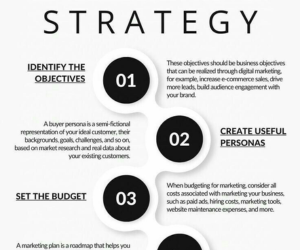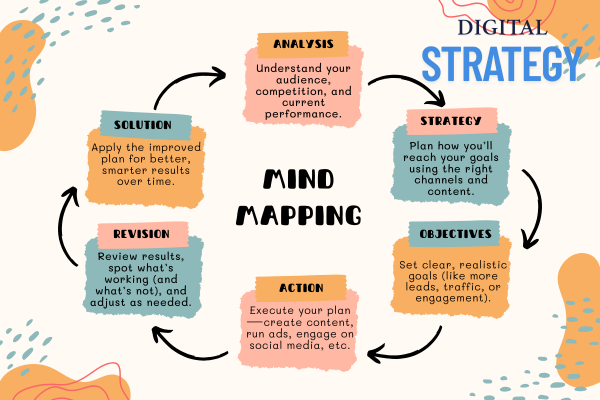How to Build a Digital Marketing Strategy That Connects in 2025

In 2025, businesses must adapt their digital marketing strategies to resonate with evolving costumer preferences and technological advancements. Crafting a digital marketing strategy that effectively engages target audiences requires a deep understanding of emerging trends and innovative approaches. By leveraging data analytics, personalization techniques, and omnichannel integration, organizations can create compelling campaigns that foster meaningful connections with consumers in the digital landscape of 2025.
In a digital world that keeps evolving, one thing remains constant: people want to connect with brands that understand them. As we step deeper into 2025, creating a digital marketing strategy isn’t just about visibility—it’s about authenticity, engagement, and value. In this guide, we’ll break down how to build a digital marketing strategy that not only reaches your audience but truly connects with them.
Why a Connection-First Strategy Matters in 2025
Digital noise is louder than ever. Users scroll past ads in seconds, skip emails in bulk, and bounce from websites that don’t grab their attention. What stops them is connection.
When a strategy is built around connection:
- Audiences feel seen and heard
- Trust builds naturally
- Conversions come from genuine interest
In 2025, brands that succeed will be the ones that prioritize relationships over reach.
Step 1: Define Your Audience Clearly
Know Who You’re Talking To
Before creating any campaign, understand exactly who you’re trying to reach. Use:
- Customer surveys
- Social media insights
- Google Analytics
- CRM data
Build Buyer Personas
Map out personas with details like:
- Age, location, job title
- Interests and hobbies
- Pain points and needs
- Where they spend time online
Knowing your audience is the first step toward connection.
Step 2: Set SMART Objectives
What Are You Trying to Achieve?
Your strategy needs direction. Set SMART goals:
- Specific
- Measurable
- Achievable
- Relevant
- Time-bound
Examples:
- Increase website traffic by 30% in 3 months
- Gain 1,000 new email subscribers by Q2
- Boost Instagram engagement by 50% in 60 days
Step 3: Choose the Right Marketing Channels
Go Where Your Audience Is
Not every platform is right for every brand. In 2025, focus on:
- Instagram & TikTok: Short-form video and storytelling
- LinkedIn: B2B content and thought leadership
- YouTube: Long-form educational content
- Email Marketing: Direct and personalized communication
- SEO & Blogging: Organic visibility and trust
Multichannel vs. Omnichannel
- Multichannel: Being present on multiple platforms
- Omnichannel: Creating a seamless experience across them
For real connection, omnichannel wins.
Step 4: Craft a Clear, Consistent Brand Voice
Why Voice Matters
Your voice is your digital personality. It builds familiarity and trust.
Examples:
- Friendly and helpful
- Bold and energetic
- Calm and informative
Keep It Consistent
Your brand voice should sound the same on:
- Website copy
- Social posts
- Email campaigns
- Customer support replies
Inconsistency confuses your audience. Consistency builds connection.
Step 5: Create Value-Driven Content
What Kind of Content Connects in 2025?
Content that:
- Solves real problems
- Answers common questions
- Educates, inspires, or entertains
Types of Content to Focus On
- How-to Guides: Break down complex topics simply
- Short Videos: Quick, engaging visuals
- Email Newsletters: Regular, helpful updates
- Live Streams: Real-time interaction
- User-Generated Content: Build community with your audience
Content is the bridge between you and your audience.
Step 6: Use Data to Personalize the Experience
Why Personalization Matters
People expect brands to know their preferences. Use data to:
- Recommend relevant content/products
- Send personalized emails
- Customize user journeys on your site
Tools to Help
- CRM systems (like HubSpot, Salesforce)
- Email marketing platforms (like Mailchimp, ConvertKit)
- Behavior tracking tools (like Hotjar, Google Analytics)
When you tailor the experience, people feel like you’re talking to them.
Step 7: Invest in SEO & Content Optimization
Be Findable, Not Just Present
Search engines are still a primary source of discovery.
Focus On:
- Keyword research (using tools like SEMrush or Ubersuggest)
- Writing helpful, well-structured content
- Optimizing for voice search and featured snippets
- Technical SEO: site speed, mobile-friendliness, etc.
Good SEO gets you seen. Great content keeps people around.
Step 8: Build Relationships Through Social Media
Be Social, Not Just Promotional
Use social media to start conversations, not just push products.
Tips:
- Reply to comments and DMs
- Share behind-the-scenes content
- Host Q&As or go live regularly
Community First
Create a community where people feel heard. That’s where real connection starts.
Step 9: Track, Analyze, and Optimize
What Metrics Matter Most?
Track:
- Engagement (likes, comments, shares)
- Website traffic and behavior
- Conversion rates
- ROI per channel
Use these insights to adjust your strategy regularly.
A/B Testing Is Key
Test different:
- Headlines
- Email subject lines
- Landing pages
- Ad creatives
Data tells you what’s working and what needs improvement.
Step 10: Stay Flexible and Keep Evolving
Digital Marketing in 2025 Will Keep Changing
New platforms, new trends, and new tools will keep emerging.
Stay ahead by:
- Following industry news
- Attending webinars and events
- Listening to your audience
Adaptability is just as important as strategy.
Final Thoughts: Connection Is the New Currency
If you want to succeed in digital marketing in 2025, stop chasing clicks and start building connections. Focus on people. Help them. Listen to them. Create content and strategies that make them feel understood.
That’s how to build a digital marketing strategy that connects in 2025.
Ready to build yours? Start simple. Stay consistent. And always keep your audience at the heart of everything you do.

Some FAQS
What is a digital marketing?
A digital marketing strategy is a structured plan that helps businesses promote their brand, products, or services online using channels like SEO, social media, email, and content marketing.
Why is connection important in a 2025 digital strategy?
Because users expect personalized, human experiences. A connection-first approach builds trust, improves engagement, and increases long-term loyalty.
How long does it take to see results from a digital marketing strategy?
Typically, it takes 3–6 months to start seeing noticeable results, depending on your goals, consistency, and chosen marketing channels.
What's the difference between multichannel and omnichannel marketing?
Multichannel means using multiple platforms separately. Omnichannel creates a seamless user experience across all platforms, helping users feel more connected.
Which digital marketing tools should I use in 2025?
Top tools include Google Analytics, HubSpot, Mailchimp, SEMrush, Canva, and Hootsuite—depending on your strategy goals.

